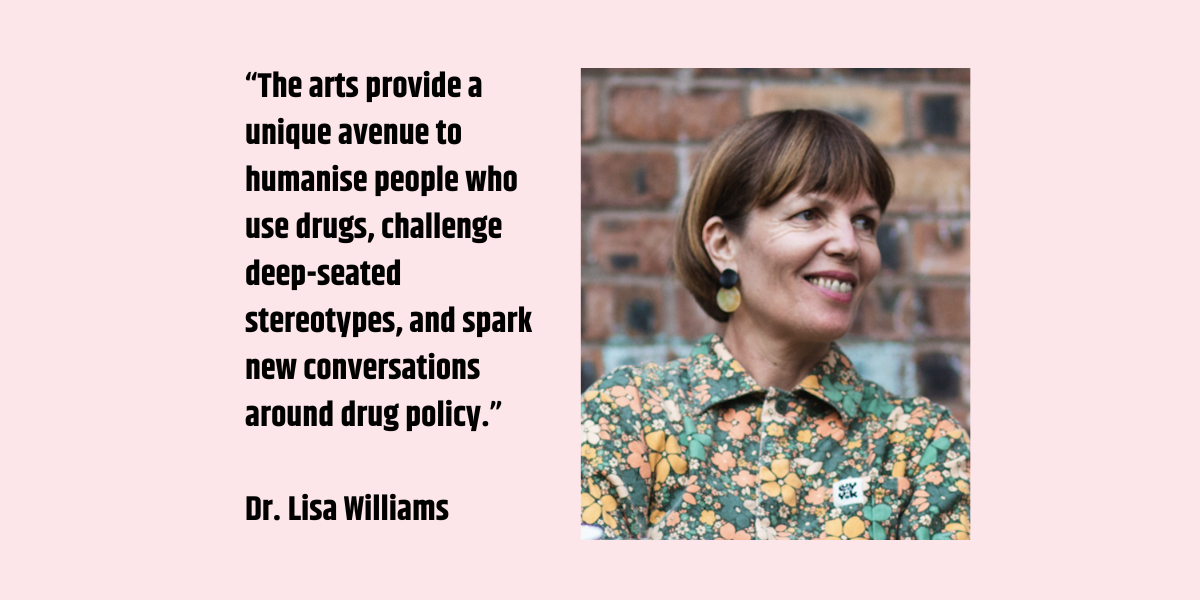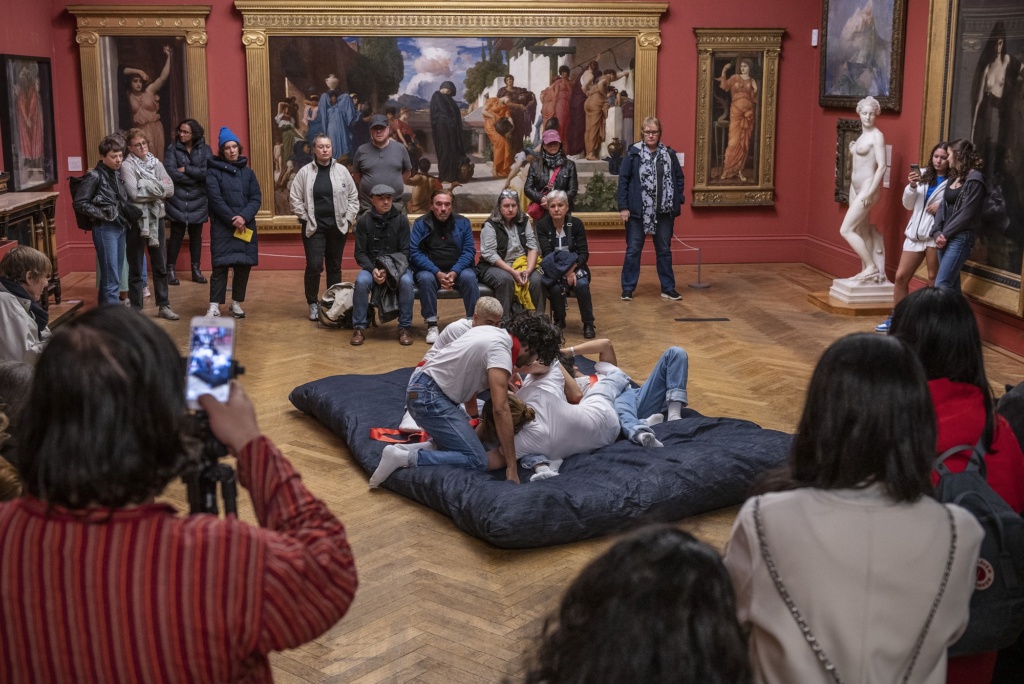
By Dr. Lisa Williams
Photo by Joe Smith.
We were honoured to sit down with our trustee, Dr Lisa Williams, to discuss her work around drug use, policy and art, and learn more about how her research aims to challenge stigma and outdated, punitive approaches to drug policy.
For over 25 years, my research at the University of Manchester has revolved around a deeply complex and often misunderstood topic: why people use drugs. My academic journey began as a researcher for the Illegal Leisure longitudinal study—an exploration of how recreational drug use evolves over the life course, which I later developed for my PhD research. My PhD culminated in my book, Changing Lives, Changing Drug Journeys, offering a comprehensive investigation of the shifting patterns of alcohol and other drug use from adolescence into early adulthood, highlighting the often non-linear nature of drug using journeys. Beyond recreational drug use, my research has also explored dependent drug use, and the implementation of policies designed to address it, including a three-year study of New Labour’s Drugs Intervention Programme and the impact of the introduction of Mandatory Drug Testing in prisons on prison drug trends such as synthetic cannabis, commonly known as ‘Spice’.

During the first 20 years of my academic research career, I employed traditional research methods such as surveys and semi-structured interviews. However, in recent years, my focus has shifted towards arts-based approaches, recognising the transformative potential of art in fostering public discussions about substance use. The arts provide a unique avenue to humanise people who use drugs, challenge deep-seated stereotypes, and spark new conversations around drug policy. One of my projects, Behind Closed Doors, examined recreational drug use within domestic settings, particularly how people store illegal drugs to avoid detection. By photographing ‘stash’ containers and their contents, inside participants’ homes, the project challenged the dominant media and policy narrative that typically frames drug use as ‘crime-driven addiction’. The findings highlight that when the participants stored drugs for recreational purposes at home, they employed harm reduction strategies, aiming to minimise risks to others, should they find them and, for instance, take them unknowingly. This work led to an exhibition featuring 40 curated images, displayed at national and international events, including Cranstoun’s inaugural Social Justice Conference in Brighton and the European Society for the Study of Drugs annual conference in Copenhagen. These exhibitions, accompanied by expert panel discussions and public debates, created crucial spaces to reflect on the problems of prohibition and the urgent need for drug policy reform. In another project, Stitching for Change, I used cross-stitching as a creative method to engage the public in conversations about drugs and drug policy. Through workshops, participants—including those with lived or living experience of drug use—crafted pieces with harm reduction messages, igniting critical dialogue about the realities of drug use and the impact of current policies. The cross-stitches were exhibited at the ESRC Festival of Social Science in 2024, with an expert panel further discussing the complexities of drug policy.
Rethinking Drug Harm: A Flawed System
One of the biggest misconceptions about drug use is that drugs themselves are inherently harmful. In reality, it is the illegality of many of these substances—and the resulting unregulated market—that fuels much of the harm. Street heroin, for example, is often cut with substances, ranging from caffeine and paracetamol through to potent synthetic opioids like fentanyl and more recently, nitazenes, leading to fluctuating potency and risk of overdose. This is one of the reasons why the UK has the highest rate of drug-related deaths in Europe. Similarly, synthetic cannabis, became popular in the UK shortly after natural cannabis was reclassified from a class C to a class B substance in 2009. Synthetic cannabis became more harmful after the 2016 Psychoactive Substances Act criminalised its sale in high street shops, pushing it into the street market where the potency and composition are more unpredictable and dealing practices are often more violent. Even ecstasy, often associated with recreational use, can be dangerous due to contamination with unknown substances or dangerously high levels of MDMA. Drug testing has revealed that some of the strongest ecstasy pills ever produced are currently circulating. If these substances were regulated—produced and sold with safety measures and education in place—many of the harms associated with them could be significantly reduced.

Trends in drug use show that the majority of people who do take drugs do not experience problems. My research has found that for most people drug taking is fairly short-lived, declining or significantly reducing as people take on the roles and responsibilities associated with adulthood, like full-time employment, home ownership and parenthood. However, this is not always the case. For those who do experience problems, we need to provide health-focused, harm reduction-oriented, non-judgemental interventions which support them where they are at and recognise that recovery can be a challenging and sometimes lonely journey for many. This is where I see the arts have a role to play in supporting people in their recovery journeys, by filling a space that stopping using alcohol and other drugs can leave, providing engaging activities that are beneficial for a person’s mental health and well-being.
Art, Recovery, and the Power of Portraits of Recovery
My journey into arts-based research led me to Portraits of Recovery and their work using the visual arts to engage people in recovery and reshape public conversations about substance use. My first encounter with Portraits of Recovery’s work was during my time as Director of methods@manchester at the School of Social Sciences, University of Manchester, where I curated the annual Methods Fair about creativity in social research. I invited Professor Amanda Ravetz from Manchester Metropolitan University to screen My Recoverist Family, a film produced in collaboration with Portraits of Recovery. The film was a turning point for me—an eye-opening experience that illuminated the non-linear nature of recovery and the immense value of artistic expression in this space.
The arts have an important role in sustaining recovery. Through creative arts production, people in recovery can embark on a journey of self-discovery in supportive social environments, enhancing their well-being, as well as strengthening their recovery. Portraits of Recovery is leading the way in using visual arts to change public perceptions about substance use, an inspiration to others in the arts sector. Recent projects like Let’s Talk About Chemsex have been particularly impactful, using recorded narratives to challenge the stigma surrounding sex on chems. Another standout initiative, Portraits of Recovery + Venture Arts in Dialogue: Spaces Between, explored the intersection of neurodiversity and dependency through collaborative painting sessions led by Manchester-based artist Will Belshah. These projects underscore the importance of creative expression in sharing lived and living experiences and shifting public perceptions.

A Call for Compassionate, Evidence-Based Drug Policy
My research aims to challenge stigma and outdated, punitive approaches to drug policy. By fostering open conversations, promoting harm reduction, and highlighting the voices of those with lived and living experience, we can move towards a more compassionate, health-focused approach to drug use. Through research, art, and dialogue, we can reshape the narrative and create a future where drug policy is rooted in evidence, compassion, and human rights, and which recognises the value of the arts for sustaining recovery and integrates them into recovery programmes. Portraits of Recovery is at the forefront of the recovery arts movement and as one of their trustees, I am excited to be on this journey with them.
Thank you so much to Dr. Lisa Williams for taking the time to write this blog post for us about her work.
If you’d like to be the first to hear about our news and updates, sign up for our emails at the box below.